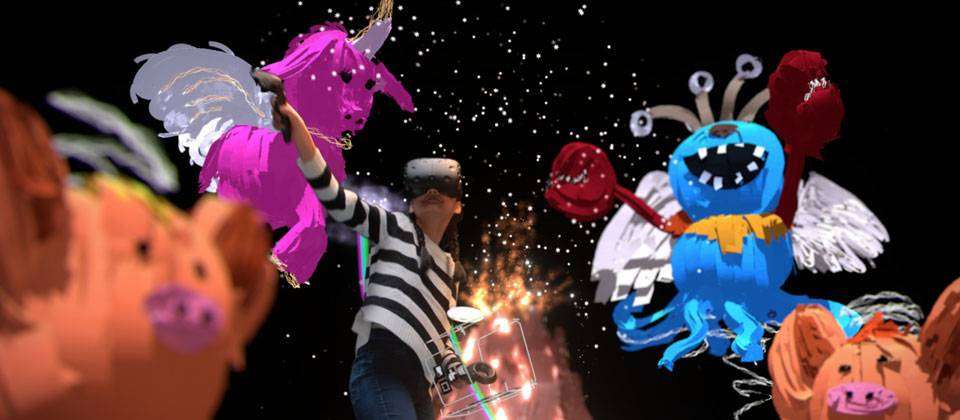Immersive virtual reality (immersive VR) is the presentation of an artificial environment that replaces users’ real-world surroundings convincingly enough that they are able to suspend disbelief and fully engage with the created environment. Immersiveness is an important element of virtual reality applications, such as VR gaming and VR therapy.
Immersiveness is usually considered on a scale or along a continuum, from least immersive to fully immersive. Typically, user engagement will vary accordingly, although to some extent dependent on individual differences. An inadequately immersive environment will not engage the user, while one that completely replicated the real world could have unpredictable psychological effects. To date, the latter scenario is not an issue because that level of immersiveness has not been achieved.
Elements of virtual environments that increase the immersiveness of the experience:
Continuity of surroundings: The user must be able to look around in all directions and have continuity of the environment.
Conformance to human vision: Visual content must conform to elements that allow humans to understand their environments, so that, for example, objects in the distance are sized appropriately to our understanding of their size and distance from us. Motion parallax ensures that our view of objects changes appropriately as our perspective changes.
Freedom of movement: It’s important that the user can move about normally within the confines of the environment. That capacity can be achieved in room-scale VR and dedicated VR rooms but requires complicated hardware for stationary VR and is impossible for seated VR.
Physical interaction: A user should be able to interact with objects in the virtual environment similarly to the way they do with real life ones. Data gloves, for example, can allow the user to make motions like pushing or turning to interact with objects in a natural way – turning a doorknob or picking up a book.
Physical feedback: The user should receive haptic feedback to replicate the feel of real-world interaction. So, for example, when a user turns a doorknob, they not only replicate the movement but experience the feeling of having that object in their hand.
Narrative engagement: The user should have the ability to decide the flow of the narrative. The environment should include cues that lead the user to create interesting developments.
3D audio: For immersiveness, VR environments should be able to replicate natural positioning of sounds relative to people and objects in the environment and the position of the user’s head.
“Mixed Reality”
The term “Mixed Reality” (MR) is used for videos where VR content is combined and overlapped with real-time film sequences. In order to do this, the person in the VR is recorded with the help of green-screen technology. The position of the real camera is then connected with the position of the virtual camera. External parties are then able to see what the person in the virtual world is currently experiencing.
What Are the Most Important Points to Consider When Creating VR Content?
360-degree content should captivate the user right from the start – the more exciting and real the content is, the longer the user will watch it, and the more often they’ll return. This is particularly important for brands and advertisers that want to include VR in their marketing repertoire and profit from it.
To create truly relevant 360-degree video content for the user, it’s important to pay attention to specific moments in the customer’s journey – so-called “moments that matter” – right from the very beginning.
Good examples of such moments might be “I’d like to test that product before I buy it”, “I want to experience it as though I were actually there” or even “I want to experience entertainment like I’ve never experienced it before”. This is a good way to reach users and customers at exactly the right moment, which can have a positive impact on the advertising effect and result in capturing the customers’ attention, increasing brand awareness, closing a sale or making a profit.
Also, there are certain principles that should be taken into consideration when creating content:
- The User Sees Everything
In the area of 360-degree films, professional production is particularly complex. Since the user can look around freely in the virtual environment, it is particularly important that equipment and other aids are not visible in front of the camera if they are not part of the scene. To hide these in the post-production phase is complicated and expensive. - Take Your Time
It takes time to tell an “immersive” story. The user wants to, should and must orient themselves within the environment. They want to understand where they are, where they’ve come from and what’s happening in order for the situation to evoke the necessary empathy. That’s why detail is such an important part of the storytelling process; it allows the user to become completely immersed in what’s happening and gives them the feeling of truly being part of the story. - Gentle Scene Changes Increase the VR Experience Seamless transitions from one scene to the next are paramount to telling a story smoothly and without any disruptions. That’s why it’s important to avoid abrupt cuts to ensure that the user has the best possible “immersion” experience. This can be particularly disruptive and detrimental to the positive experience when using a viewer like Cardboard. Soft fading gives the viewer time to prepare for the scene change and reorient themselves in the new environment.
- Sound, Movement and Animation Effects Help to Tell the Story 360-degree technology presents film directors with new challenges. If something happens that’s an important part of the story, but the viewer doesn’t see it, it’s possible that some information is missing which the viewer needs in order to fully understand the story. Spatial audio – a 3D sound that the viewer can experience in the virtual space – can help in such cases. Furthermore, the visual design of the scene, as well as movement and animation can help to ensure that the viewers’ attention is focused on what’s happening.
Conclusion
360-degree videos, “Virtual Reality,” and “Augmented Reality” are new technologies that can be put to great use by brands and advertisers in a wide variety of ways to capture consumers’ attention. “Immersion” – the act of immersing oneself in other worlds – provides the user with an extraordinary experience filled with emotional intensity, thus reinforcing both customer relationships and brand recognition making the experience more effective when compared to conventional methods. This can lead to the best possible end result for both the customer and the brand if such strategies are used at the right moment and employ high-quality content.
Immersion VR – Everything You Need to Know
- Technology
Categories:
June 28, 2019
What is actually meant by “immersive content” or “immersion VR”? Did the term ‘immersion’ originate with the onset of new technology such as augmented reality, virtual reality or mixed reality?
We’ll give you the answers you’re looking for!
In this article we will tell you everything you need to know about the term “immersion”!
Precise Definition of Immersion in Virtual Reality
Immersion (the technical term for immersing oneself in an artificial world) describes the effect caused by a situation, environment or graphic representation which makes the user’s consciousness recede into the background so that the virtual environment is perceived as reality.
Nikolayi Engelmann
This is how Nikolayi Engelmann describes it in his book “Virtual Reality Gaming”.
The term ‘immersion’ comes from the Latin immersio, which means to immerse.
Different Types of Immersion
Immersion can be divided into two types. On the one hand, there is mental and physical immersion. Both of these target the same thing. However, we can broadly say that physical immersion enhances mental immersion.
Mental Immersion
This kind of immersion occurs when the user submerges themselves in a certain storyline. In other words, they dive right into it.
We all know what it is like and have probably experienced mental immersion a number of times. For example, when we are reading an exciting book and imagine the action in our heads using vivid images. Sometimes we are also disappointed, can’t believe it or are even sad when a certain plot in a film doesn’t turn out as we imagined it would.
It is in these moments that we feel a deep commitment to various plots and are willing to accept fiction or fantasy.
Physical Immersion
Physical immersions are more of a proverbial “on top” to mental immersion. All the physical things that our diverse senses perceive increase and strengthen mental immersion.
What exactly does that mean?
As an example, let’s take a fictional VR game where you have super powers and can fly. We put on our glasses and start our adventure as Superman.
It is in this moment that the first physical immersion happens solely through VR. We are shielded from the outside world. No matter how we turn our head, we will always be looking into the virtual environment.
Then we take off. What could increase our physical immersion when flying?
A cold stream of wind blowing against us!
Let’s imagine that fans suddenly start blowing in our gaming room as soon as we begin to fly in VR. This way, our body will actually feel the wind and cold. The whole experience suddenly becomes much more immersive than before.
At this point, we could give many examples of how we could influence our senses to intensify physical immersion. I am thinking here of special gloves with haptic feedback, smells and tracking treadmills. What else do you have in mind?
Where does the term actually come from?
You hear the garden door open. You run for cover as soon as you can. Leaning against the wall, your breathing gets faster and faster, with adrenaline pumping through your veins.
With your gun drawn, you take a quick look around the corner. Your housemates have no idea you’re waiting for them. You slowly put on the weapon and press it against your shoulder. You press your head against the cold, mental end of the weapon to target one of your housemates through the aimer.
You wait for the right moment. Your breathing slows down and your knees begin to shake. You pull the trigger with purposeful intent. Your target falls to the ground.
This is not the story of an exciting thriller, but just a normal afternoon in the life of a little boy playing in the garden with his parents.

Regardless of the role played back then, whatever castles you built or how many toy cars crashed into each other: The fictional ideas that permeate children’s games were probably the most immersive experiences we all enjoyed.
Although the term ‘immersion’ is a constant companion to Virtual Reality, it is by no means the result of new technologies. It has been used in various fields since the 17th century.
We should also consider the term ‘presence’.
It’s a term we all know the meaning of. In short, it means ‘being there’.
In the context of immersion, however, a somewhat different kind of presence is meant. It’s a derivative of the word “telepresence”.
Telepresence describes the state of feeling present in a distant or virtual environment. For this reason, it can be seen as an essential feature of Virtual Reality.
In a nutshell, the higher the immersion, the more real or present the user feels in the distant environment.
Again, presence or telepresence are not terms derived from the environment of Virtual Reality technology. It has existed for a long time, just like the term ‘immersion’.
You can feel a certain amount of telepresence even when you’re on the phone. This is because two people that are located in completely different places are – at least acoustically – in one and the same room through a communication medium.
For this reason, immersion is also a basic prerequisite for presence when it comes to VR.
Immersion in Virtual Reality

The feeling of immersion can be achieved especially well through Virtual Reality. And it’s much easier than with a normal TV series or a film. I have already mentioned that immersion can be enhanced very well within VR through shielding.
Our bodies and brains are more prone to trust what we see. We all too often let ourselves be deceived in our everyday lives by what we see. Our brain can quickly adapt to Virtual Reality and accepts the “unreal” world.
Due to the acceptance and the presence that results from it, you can quickly experience unattractive side effects such as “motion sickness”.
While our brain thinks it is running in Virtual Reality, the body sends signals that it is actually standing or sitting still, because in reality you are only wearing VR glasses. It is precisely these contradictory signals that can quickly make you sick. A clear case of “motion sickness”
Strengthening Immersion within VR Using Technical Means
There are certain techniques that make it possible to increase the immersion of users. Two good examples here would be:
Spatial sound
Spatial sound has long since found its way into the gaming industry. Using spatial sound, the sound in the game follows the visual effects.
You can also use spatial sound very effectively within Virtual Reality. It is not only suitable for games, but also for storytelling to help direct the user’s gaze.
You can vividly imagine a user constantly rotating their head in a 360° city tour. So that they can really see everything.
The gaze of the users can be controlled with a simple tour guide that is placed correctly. The sound of their voice actually comes from the direction they are speaking or where they are standing at that moment.
Interactivity within Virtual Reality
Involve your users in the content of a VR experience. It is possible to greatly increase immersion by getting the user to interact with the content.
The user could decide the order of the scenes by choosing a certain path themselves. It is precisely this aspect that our customers rely on. Users can interact with various hotspots or move from scene to scene. This way, they are able to move freely in VR.
Is it possible to create a fully immersive Virtual Reality?
Ah, the holy grail of Virtual Reality technology. Total immersion in the content. Boundless devotion. The virtual world is becoming a reality.
A conceivable scenario, but not feasible with today’s technology. This requires a whole lot of fictional technology.
A fully immersive virtual world would be able to reproduce each of our senses, thoughts and so much more in a completely artificial environment. Absolutely no detail may be omitted here. Any disturbance, or even the slightest contradictory signal (we’ve already spoken about this) to our body would pull us out of the fully immersive world. And suddenly we’d realize that it wasn’t all real.
It simply requires too much additional technology, which does not even exist today. Where would you even start? How do we address our senses of touch or smell in a technical manner?
From a historical point of view, VR technology is still in its infancy. It was only this year that Oculus managed to achieve acceptable room scaling without cables or separate tracking cameras with the Quest. That would have been unthinkable three years ago.
Is there also such a thing as non-immersive Virtual Reality?
Since there are no fully immersive Virtual Reality experiences at this current stage of development, we can now ask ourselves the following question:
What about non-immersive experiences? Does Virtual Reality always have to be completely immersive to be successful?
No!
As we have already learned, Virtual Reality always bring a certain degree of immersion with it. However, complete immersion is not necessary to create a good VR experience.
You don’t have to be taken off into another world to enjoy a 360° view of an apartment. Nevertheless, such an experience gives me exactly the information I need.
Uncanny Valley – Acceptance Limits Vary from Person to Person!

There is no guarantee of immersion within VR. After all, what causes one user to feel completely immersed can leave another user cold. There is a gap in the acceptance of artificial content.
This gap is known as the “uncanny valley”. The “valley” describes a strong slump in a curve diagram, which represents the acceptance of artificial content.
This acceptance differs from person to person, especially in the area of Virtual Reality.
Previous experience and a sense of entitlement are the archenemies of immersion. Virtual content is viewed much more critically by experienced users than by users wearing VR glasses for the first time.
As a general rule, newcomers are usually over the moon. On the other hand, experienced users often ask technical questions such as “What is the device’s pixel density?” Is that even 60 FPS right now? etc.
What do you think about immersion in VR?
Have you already had some experiences in Virtual Reality? What exactly did you try and how did you feel about it?
Please share any comments you have about this topic – we would love to hear from you!




